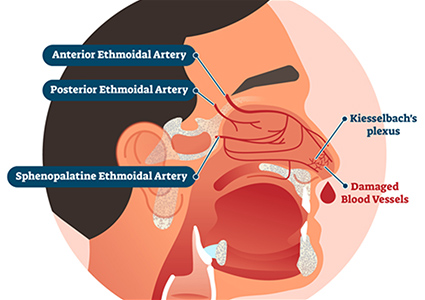Epistaxis – or nosebleed in common parlance – occurs in more than half of the population and accounts for approximately 0.5 percent of emergency department visits. Most instances of epistaxis are isolated or resolve without treatment, but epistaxis recurs in approximately 16 percent of individuals prompting them to seek medical care.
Epistaxis – or nosebleed in common parlance – occurs in more than half of the population and accounts for approximately 0.5 percent of emergency department visits. Most instances of epistaxis are isolated or resolve without treatment, but epistaxis recurs in approximately 16 percent of individuals prompting them to seek medical care.
“About 60 percent of the country’s population will have a nose bleed at some point in their life,” says David A. Gudis, MD, Chief of the Division of Rhinology and Anterior Skull Base Surgery in the Department of Otolaryngology – Head and Neck Surgery at NewYork-Presbyterian/Columbia University Irving Medical Center. “For the vast majority of those patients, nose bleeds are self-limiting and stop on their own or they are an isolated incident rather than a recurrent or chronic problem. When they are frequent, nose bleeds can disrupt work and social life, and when they are severe, they can be life-threatening.”
Dr. David Gudis
Recurrent nosebleeds can often be managed by simply holding pressure on the nose. “In some cases medical or surgical intervention is necessary,” notes Dr. Gudis. “In rare cases, very severe or frequent unilateral nosebleeds could warrant concern for a more serious condition, such as a benign or malignant neoplasm of the nasal cavity, sinuses, or skull base. And some nosebleeds involve such a significant amount of blood loss that they can result in airway obstruction or a life-threatening emergency. If a nosebleed is severe enough that it can fill up a cup with blood, then we are in the territory of a situation where urgent medical attention is necessary.”
Nasal Cauterization: Stopping a Nosebleed in its Tracks
There are two forms of epistaxis – anterior and posterior – distinguishable by their respective blood supplies. Cauterization with topical silver nitrate is generally the treatment of choice for anterior epistaxis. Most cases of anterior epistaxis involve Kiesselbach’s plexus, and although the blood vessels here may be small, bleeding can be vigorous and bothersome. The mucosa overlying the vessels in the anterior nasal cavity is thin and prone to injury. Cold, dry air and recurrent trauma commonly instigate bleeding from the anterior nasal cavity. “In the case of a deviated nasal septum, the inner part of the nose can be a place of turbulent airflow,” notes Dr. Gudis. “Even though it's essentially unnoticeable to the average person, over time it can cause trauma to the mucous membrane that covers Kiesselbach’s plexus and cause recurrent nosebleeds.” The lateral nasal wall, supplied primarily by the sphenopalatine artery, is often the location of posterior epistaxis, which is less common than anterior epistaxis, more robust, and often requires nasal packing or surgery.
Nosebleeds usually come from the Kiesselbach’s plexus, where a number of arterial branches converge.
In a Video in Clinical Medicine featured in the June 24, 2021, online issue of The New England Journal of Medicine, Dr. Gudis demonstrates the evaluation of a patient with recurrent epistaxis and a technique that can be used to perform nasal cauterization in the office setting.
Determining the Cause
To understand the cause of recurrent epistaxis and what may be contributing factors, Dr. Gudis recommends conducting a detailed patient history that includes:
- Frequency
- Severity
- Location
- Laterality of recent nosebleeds
- Personal or family history of bleeding disorders
- Additional clinical issues, including recent surgery or trauma, and use of anticoagulant or antiplatelet medications, intranasal medications, or drugs
Performing a complete examination of the head and neck is critical. Facial asymmetry or cervical lymphadenopathy may suggest a neoplasm. Hemotympanum may indicate that blood has refluxed through the eustachian tubes to the middle ear. Blood or a clot in the oropharynx may show active or recent bleeding. One condition, called hereditary hemorrhagic telangiectasia (HHT), is a genetic disorder that causes abnormal blood vessel formation. The most frequent symptom is severe nosebleeds, but the condition also causes abnormal blood vessels in other parts of the body.
“This is a rare, often misdiagnosed disorder that is generally not well understood by many physicians,” says Dr. Gudis. “Individuals with HHT can lose a pint of blood every time they take a very hot shower or bend over to tie their shoes. Even in the absence of a family history, spontaneous mutations can cause this condition, so it’s a diagnosis that needs to be considered in patients who have frequent or recurrent epistaxis.”
Applying the Treatment
If home remedies don’t work or the nosebleeds are troublesome, an application of silver nitrate can put a stop to the nosebleed. “Silver nitrate is a chemical that has been used in medicine for hundreds of years for many different purposes, and one thing it does very well is cause sclerosis of blood vessels,” says Dr. Gudis. “Essentially the silver ions in the silver nitrate are released around the blood vessels and cause an inflammatory reaction that creates scarring in the small arteries and veins in the nose. This minimizes blood flow through the vessels making them far less likely to bleed.”
In the clinical video, Dr. Guidis provides step-by-step instruction on the cauterization, noting that only one side of the nasal septum should be cauterized at a time to avoid risk of perforating the septum. A nasal speculum should be used to perform anterior rhinoscopy. The anterior nasal cavity also can be examined by gently elevating the nasal tip. The examination should include the bilateral vestibule, anterior septum, inferior turbinate, and the floor of the nasal cavity to uncover the presence of any prominent blood vessels within the mucosa. Following administration of topical anesthesia, the silver nitrate is then applied to the prominent blood vessel and surrounding mucosa.
Dr. Gudis notes that even after adequate topical anesthesia has been administered, the procedure may still cause pain, burning, headache, foul taste, or excessive sneezing or tearing and he recommends advising the patient about these possible reactions. “Nasal cauterization can be performed in the office, but for those patients who are unable to follow instructions or who cannot tolerate brief discomfort, the procedure is best performed in the emergency department,” adds Dr. Gudis. “The treatment does not disturb a patient’s sense of smell, and every once in a while, patients will get a gray or silver discoloration at the front of their nostril that takes a day or two to go away.”
Aftercare includes topical moisturizing agents, such as nasal saline gel, to protect the nasal cavity area as it heals and ease the burning sensation that can follow cauterization. Over-the-counter acetaminophen or nonsteroidal anti-inflammatory drugs may be used, if necessary. Dr. Gudis emphasizes that when performed in a conscious patient who is able to follow instructions, cauterization with silver nitrate is a straightforward procedure in managing recurrent epistaxis.






